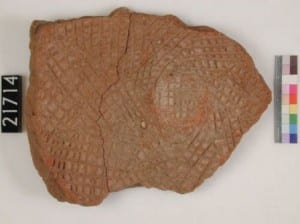Pottery Project Guest Blog: The Enigmatic Fish Dishes of the Petrie Museum
By Alice Stevenson, on 21 March 2014
Guest blog by Mary Ownby and Bettina Bader
In the third in our series of different perspectives on Egyptian pottery Mary Ownby, Petrographic Researcher at Desert Archaeology Inc, and Bettina Bader, Institut für Ägyptologie der Universität Wien, investigate the purpose of vessels that Egyptologists find puzzling.
Analysis of Egyptian pottery provides great insight into how the Egyptians worked, ate, carried out religious activities, and related to the larger social and economic system. For most vessels, their shape can inform on their use, i.e. a jar is probably for storage, a large pot with a narrow opening for cooking, and bowls and plates for serving food. The location where ancient pottery has been found can also inform on how it was used, for example in an oven, or as ritual implements in the burial. In Egypt, depictions on tomb and temple walls as well as some texts also tell us about the variety of purposes ceramic vessels were used for. Thus, most ancient Egyptian pottery has a fairly clear use in the past.
Pots being put to good use. Bread making scene from the Old Kingdom Tomb of Ti at Saqqara.
An exception is provided by the so-called “fish dishes”. These vessels are oval platters with slightly raised sides or of even height all around. Their name derives from the incised designs they feature that often show fish in a watery scene. However, other dishes feature various plant and animal life or geometric patterns. They first appear in the late Middle Kingdom, ca. 1850 to 1650 BC, at sites such as Tell el-Yahudiye, Lahun, Abydos, and Qau in Middle Egypt as well as at Buhen in Nubia. Themain sites that supplied the almost 20 examples of fish dishes held in the Petrie Museum are Tell el-Yahudiye, Lahun and Qau. Recent archaeological work has supplemented this collection with examples from Memphis, near Cairo, and Tell el-Dab’a in the Delta. Nevertheless, the purpose of these vessels has remained unclear.
Several theories have been suggested for how fish dishes were used by the Ancient Egyptians. One idea is that by incising designs in wet clay ridges were created that were used to scale fish, which has proven impractical in a trial. Another was that bread was baked in the dishes that would then have light impressions of the design. Also the husking of grain has been put forward as a possible use. For these ideas, evidence is lacking as none of the vessels have been found with fish scales or with sooting marks from the oven, although in one instance a grain was found imbedded within the incised decoration. They may have a more ritual function and some of those found at Tell el-Dab’a were a part of a deposit believed to include the remains of feasting.
Other studies of fish dishes have focused on the materials used to make them in order to see if that would shed light on their function. One approach was to see if there were chemical differences in the clay and temper (intentionally added sand and limestone) used to make them. A previous chemical study had suggested there could be, but it was unclear how this related to where the dishes were found and differences in design. As the Petrie Museum examples are, by and large, intact, a non-destructive method of analysis was needed. A study of similar vessels by non-destructive X-ray fluorescent spectrometry at University College London suggested this method was unlikely to detect subtle chemical differences between the fish dishes, which are mostly made of calcareous clays with various amounts of sand and limestone. (A future blog will outline in more detail the scientific methods for ceramic analysis in Egyptian Archaeology).
Thus, even in attempts to study them, the fish dishes have remained enigmatic, seeming unwilling to reveal their secrets. The Petrie Collection, however, will continue to be one of the principal sources for our existing knowledge on fish dishes since they have many that are nearly complete, and one day we may begin to understand their role in Ancient Egyptian society.
These dishes have also caught the eye of UCL students. See undergraduate Rebbeca Thompson’s thoughts on these vessels here.
2 Responses to “Pottery Project Guest Blog: The Enigmatic Fish Dishes of the Petrie Museum”
- 1
-
2
Bettina Bader wrote on 18 September 2014:
Dear Peter, this is very interesting!
Are these dishes you found generally with linear decoration only and made from Nile Clay fabrics? There seems to be a distinction between those made from Marl C and the NIle clay ones – in terms of decoration as well as material – perhaps this extends also to the function? Unfortunatley too few dishes with good archaeological contexts are published in detail to get a better idea on this.
 Close
Close





I found a great many at Deir el-Ballas in what appeared to be a bakery. Some even had chaff stuck in the incisions. Villagers today use similar trays to bake sun bread and often incise the surface with lines to keep the bread from sticking.